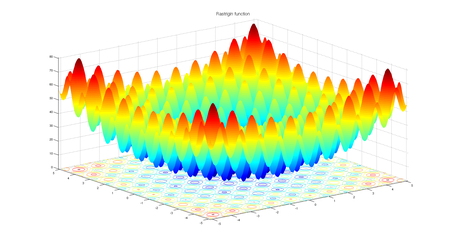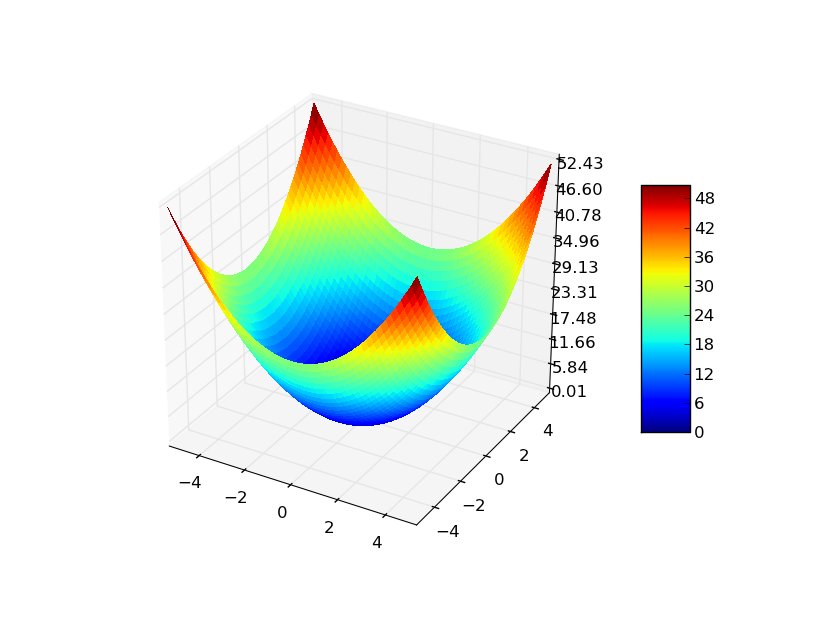基于教与学的优化实施
上一篇文章Teaching Learning based Optimization (TLBO) 谈到了Teaching Learning based Optimization的灵感,它是数学建模和算法。在本文中,我们将为两个适应度函数 1) Rastrigin函数2) 球体函数实现基于教学学习的优化 (TLBO)。该算法将运行预定义的最大迭代次数,并尝试找到这些适应度函数的最小值。
健身函数
1) 拉斯特里金函数
Rastrigin函数是非凸函数,常被用作优化算法的性能测试问题。
函数方程:
![]()
![]()

图 1:2 个变量的 Rastrigin函数
对于优化算法,rastrigin函数是一个非常具有挑战性的函数。它的复杂行为导致优化算法经常停留在局部最小值。在平面上有很多余弦振荡会为该函数引入复杂的行为。
2) 球面函数
球面函数是用于评估优化算法性能的标准函数。
函数方程:
![]()
![]()

图 2:2 个变量的球体函数
超参数的选择
问题参数:
- 维数 ( d ) = 3
- 下限 ( minx ) = -10.0
- 上限 ( maxx ) = 10.0
算法的超参数:
- 粒子数 ( N ) = 50
- 最大迭代次数 ( max_iter ) = 100
输入
- 健身函数
- 问题参数(上面提到的)
- 总体大小 ( N ) 和最大迭代次数 ( max_iter )
- 算法特定的超参数(在基于学习的优化教学中没有)
伪代码
基于教学的优化的伪代码在上一篇文章中已经描述过。还讨论了存储学生的数据结构以及存储特定于个别学生的数据的数据结构。
执行
Python3
# python implementation of Teaching learning based optimization (TLBO)
# minimizing rastrigin and sphere function
import random
import math # cos() for Rastrigin
import copy # array-copying convenience
import sys # max float
#-------fitness functions---------
# rastrigin functon
def fitness_rastrigin(position):
fitness_value = 0.0
for i in range(len(position)):
xi = position[i]
fitness_value += (xi * xi) - (10 * math.cos(2 * math.pi * xi)) + 10
return fitness_value
#sphere function
def fitness_sphere(position):
fitness_value = 0.0
for i in range(len(position)):
xi = position[i]
fitness_value += (xi*xi);
return fitness_value;
#-------------------------
#Student class
class Student:
def __init__(self, fitness, dim, minx, maxx, seed):
self.rnd = random.Random(seed)
# a list of size dim
# with 0.0 as value of all the elements
self.position = [0.0 for i in range(dim)]
# loop dim times and randomly select value of decision var
# value should be in between minx and maxx
for i in range(dim):
self.position[i] = ((maxx - minx) *
self.rnd.random() + minx)
# compute the fitness of student
self.fitness = fitness(self.position)
# Teaching learning based optimization
def tlbo(fitness, max_iter, n, dim, minx, maxx):
rnd = random.Random(0)
# create n random students
classroom = [Student(fitness, dim, minx, maxx, i) for i in range(n)]
# compute the value of best_position and best_fitness in the classroom
Xbest = [0.0 for i in range(dim)]
Fbest = sys.float_info.max
for i in range(n): # check each Student
if classroom[i].fitness < Fbest:
Fbest = classroom[i].fitness
Xbest = copy.copy(classroom[i].position)
# main loop of tlbo
Iter = 0
while Iter < max_iter:
# after every 10 iterations
# print iteration number and best fitness value so far
if Iter % 10 == 0 and Iter > 1:
print("Iter = " + str(Iter) + " best fitness = %.3f" % Fbest)
# for each student of classroom
for i in range(n):
### Teaching phase of ith student
# compute the mean of all the students in the class
Xmean = [0.0 for i in range(dim)]
for k in range(n):
for j in range(dim):
Xmean[j]+= classroom[k].position[j]
for j in range(dim):
Xmean[j]/= n;
# initialize new solution
Xnew = [0.0 for i in range(dim)]
# teaching factor (TF)
# either 1 or 2 ( randomly chosen)
TF = random.randint(1, 3)
# best student of the class is teacher
Xteacher = Xbest
# compute new solution
for j in range(dim):
Xnew[j] = classroom[i].position[j] + rnd.random()*(Xteacher[j] - TF*Xmean[j])
# if Xnew < minx OR Xnew > maxx
# then clip it
for j in range(dim):
Xnew[j] = max(Xnew[j], minx)
Xnew[j] = min(Xnew[j], maxx)
# compute fitness of new solution
fnew = fitness(Xnew)
# if new solution is better than old
# replace old with new solution
if(fnew < classroom[i].fitness):
classroom[i].position = Xnew
classroom[i].fitness = fnew
# update best student
if(fnew < Fbest):
Fbest = fnew
Xbest = Xnew
### learning phase of ith student
# randomly choose a solution from classroom
# chosen solution should not be ith student
p = random.randint(0, n-1)
while(p==i):
p = random.randint(0, n-1)
# partner solution
Xpartner = classroom[p]
Xnew = [0.0 for i in range(dim)]
if(classroom[i].fitness < Xpartner.fitness):
for j in range(dim):
Xnew[j] = classroom[i].position[j] + rnd.random()*(classroom[i].position[j] - Xpartner.position[j])
else:
for j in range(dim):
Xnew[j] = classroom[i].position[j] - rnd.random()*(classroom[i].position[j] - Xpartner.position[j])
# if Xnew < minx OR Xnew > maxx
# then clip it
for j in range(dim):
Xnew[j] = max(Xnew[j], minx)
Xnew[j] = min(Xnew[j], maxx)
# compute fitness of new solution
fnew = fitness(Xnew)
# if new solution is better than old
# replace old with new solution
if(fnew < classroom[i].fitness):
classroom[i].position = Xnew
classroom[i].fitness = fnew
# update best student
if(fnew < Fbest):
Fbest = fnew
Xbest = Xnew
Iter += 1
# end-while
# return best student from classroom
return Xbest
# end pso
#----------------------------
# Driver code for rastrigin function
print("\nBegin teaching learning based optimization on rastrigin function\n")
dim = 3
fitness = fitness_rastrigin
print("Goal is to minimize Rastrigin's function in " + str(dim) + " variables")
print("Function has known min = 0.0 at (", end="")
for i in range(dim-1):
print("0, ", end="")
print("0)")
num_particles = 50
max_iter = 100
print("Setting num_particles = " + str(num_particles))
print("Setting max_iter = " + str(max_iter))
print("\nStarting TLBO algorithm\n")
best_position = tlbo(fitness, max_iter, num_particles, dim, -10.0, 10.0)
print("\nTLBO completed\n")
print("\nBest Student found:")
print(["%.6f"%best_position[k] for k in range(dim)])
fitness_value = fitness(best_position)
print("fitness of best Student = %.6f" % fitness_value)
print("\nEnd TLBO for rastrigin function\n")
print()
print()
# Driver code for Sphere function
print("\nBegin teaching learning based optimization on sphere function\n")
dim = 3
fitness = fitness_sphere
print("Goal is to minimize sphere function in " + str(dim) + " variables")
print("Function has known min = 0.0 at (", end="")
for i in range(dim-1):
print("0, ", end="")
print("0)")
num_particles = 50
max_iter = 100
print("Setting num_particles = " + str(num_particles))
print("Setting max_iter = " + str(max_iter))
print("\nStarting TLBO algorithm\n")
best_position = tlbo(fitness, max_iter, num_particles, dim, -10.0, 10.0)
print("\nTLBO completed\n")
print("\nBest Student found:")
print(["%.6f"%best_position[k] for k in range(dim)])
fitness_value = fitness(best_position)
print("fitness of best Student = %.6f" % fitness_value)
print("\nEnd TLBO for sphere function\n")输出
Begin teaching learning based optimization on rastrigin function
Goal is to minimize Rastrigin's function in 3 variables
Function has known min = 0.0 at (0, 0, 0)
Setting num_particles = 50
Setting max_iter = 100
Starting TLBO algorithm
Iter = 10 best fitness = 3.662
Iter = 20 best fitness = 0.389
Iter = 30 best fitness = 0.389
Iter = 40 best fitness = 0.389
Iter = 50 best fitness = 0.200
Iter = 60 best fitness = 0.132
Iter = 70 best fitness = 0.051
Iter = 80 best fitness = 0.003
Iter = 90 best fitness = 0.001
TLBO completed
Best Student found:
['0.000593', '-0.000040', '-0.000461']
fitness of best Student = 0.000112
End TLBO for rastrigin function
Begin teaching learning based optimization on sphere function
Goal is to minimize sphere function in 3 variables
Function has known min = 0.0 at (0, 0, 0)
Setting num_particles = 50
Setting max_iter = 100
Starting TLBO algorithm
Iter = 10 best fitness = 0.009
Iter = 20 best fitness = 0.000
Iter = 30 best fitness = 0.000
Iter = 40 best fitness = 0.000
Iter = 50 best fitness = 0.000
Iter = 60 best fitness = 0.000
Iter = 70 best fitness = 0.000
Iter = 80 best fitness = 0.000
Iter = 90 best fitness = 0.000
TLBO completed
Best Student found:
['0.000000', '-0.000000', '-0.000000']
fitness of best Student = 0.000000
End TLBO for sphere function参考
研究论文: RV Rao、VJ Savsani 和 J. Balic (2012) 无约束和有约束实参数优化问题的教学优化算法,工程优化,44:12,1447-1462,DOI:10.1080/0305215X.2011.6521
实施灵感: https : //www.mathworks.com/matlabcentral/fileexchange/65628-teaching-learning-based-optimization# :~: text= Teaching%20Learning%20Based%20Optimization%20is,teacher%20and% 20the% 20student%20phase。